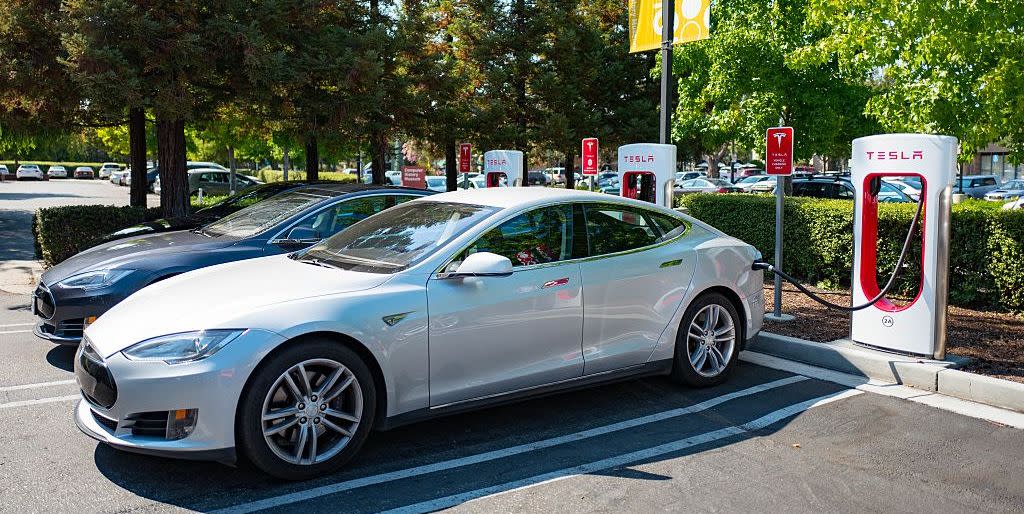Electric-Car Owners Hard Hit by Massive California Power Shutdown

Nearly a million Californians are now without power as the electric company deliberately shut it off this week, fearing high winds would spark wildfire.
The affected area in Northern California surrounds Fremont, home of Tesla, and a great many electric-car owners who can't charge their vehicles as usual.
Tesla's Elon Musk is swapping in battery Powerpacks and solar power for Superchargers in the region as fast as he can get permits, he claims on Twitter.
Nature built California to burn. And there's only so much Elon Musk, Pacific Gas & Electric, or anyone else can do to diminish that.
"All Tesla Supercharger stations in regions affected by California power outages will have Tesla Powerpacks within next few weeks," Elon Musk tweeted this morning in response to PG&E's shutoff of power to several California regions in order to minimize the risk of wildfire from high winds. "Just waiting on permits."
Also adding Tesla Solar to our Supercharger stations as fast as possible. Goal is 24/7 clean power with no blackouts.
— Elon Musk (@elonmusk) October 10, 2019
"Waiting on permits" may as well be California's state motto. And there's never any guarantee they'll actually come.

Weeks can be a long wait if you’re looking at a Model 3 in your garage with a drained battery, no electrical power to charge it, and the closest grocery store with power 80 miles away. But such is life in the Golden State, where forests and chaparral are all on hair triggers ready to ignite with slightest transformer malfunction or transmission line break. And the political environment demands minimal risk after the 2018 fire season produced 8527 conflagrations burning an astonishing 1,893,913 acres of wild lands and more than 18,000 structures. Those fires also took the lives of 97 civilians and six firefighters.
The logic behind the planned power outages is explained on PG&E's special website dedicated to tracking and preparing for them. "To protect public safety, PG&E has turned off power due to gusty winds and dry conditions combined with a heightened fire risk," the site explains. "Once the weather subsides and it is safe to do so, PG&E crews will begin patrolling power lines, repairing damaged equipment, and restoring customers."
These aren't short-term outages where the major consequence is missing the morning’s episode of The Price Is Right. "Outages (weather event plus restoration time) could last longer than 48 hours," the company warns. "For planning purposes, PG&E suggests customers prepare for outages that could last several days."
On the second day of the outages, the Wall Street Journal reports 700,000-plus customers are without power in northern California, including areas such as the East Bay abutting Berkeley and Oakland.
And if there's one place where Tesla sells a lot of cars, it's the East Bay. Not only does the area contain Fremont, the city where the Tesla assembly plant is located, it's also maybe the place most politically attuned to the idea and aspirations of electric-car ownership. And there's plenty of money there to purchase such vehicles.
Tesla owners may, in many instances, be better prepared for such outages than those without electric vehicles. The Tesla Powerwall 2 home battery can provide power for a home for up to seven days, claims Tesla. For Californians with solar power installations and the horsepower to afford $14,100 for the batteries plus a few grand more for installation, they may never have to experience a single sip of warm kombucha.
Fire is a natural part of the California ecosystem. What's not so natural is running high-tension power lines across a populous state that's often done a brilliant job putting out fires to protect property and lives. But those efforts leave behind growth and brush that is still prepared to burn—making the next fire there even more intense.
It's also the state with mandated solar installations for new construction, another mandating the sale of zero-emission vehicles, and yet one more planning to replace conventional electricity generation with renewable technologies many doubt can reliably handle the demand.
California is experimenting with its power-generation future. And right now, that experiment is hurting. Particularly those electric car owners with dead batteries.
You Might Also Like

